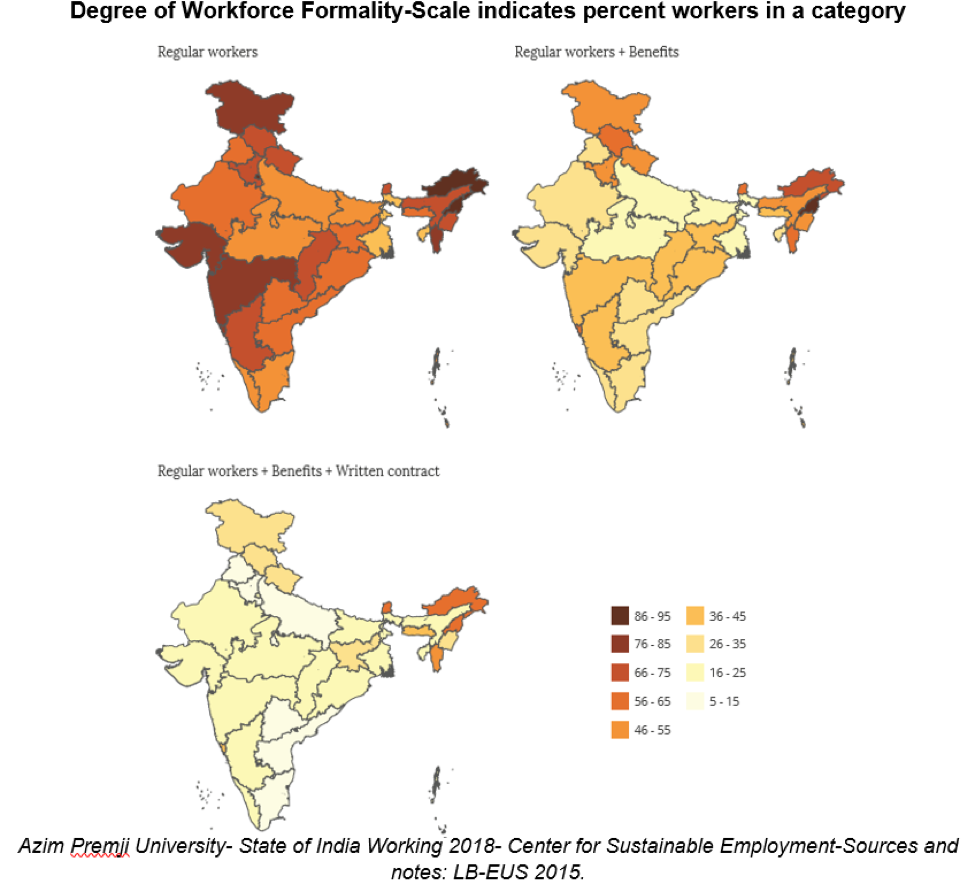The Indian workforce is highly stratified and segmented. A strong vetting system of key indicators of skills training is tremendously valuable for policymakers when formulating effective training programmes catered to specific population needs. In Part 1 of this article, we talked about the urban-rural differences, employment, and state wise split. In Part II, we will examine the degree of formality in apprenticeship as well as NATS split and ITI split.
Levels of Formality
A big chunk of employment in rural India is in the unorganised or informal sector which come with associated risks such as no protection by labour laws, absence of health & safety concerns, no minimum wage guarantees etc. One of the primary aims of policy makers in skills training should be to identify states and regions with large swathes of informal workers and intervene with targeted skills training measures to bring them into the formal workforce.
The State of India Working 2018 report found extremely low levels of formal workforce participation in Bihar and Jharkhand. On the other hand, the North-eastern states fare much better with above average levels of formalisation. Contrary to popular perception, states from the South, other than Kerala, fall behind states such as Maharashtra and Gujarat in degree of formality.


NATS Regional Split
The National Apprenticeship Training Scheme (NATS) was brought about by the Apprenticeship Act 1961 to impart vocational training to fresh graduates, diploma holders and 10+2 vocational pass-outs. NATS is central to the government’s efforts to boost vocational training in the country. We examine the regional distribution of NATs. Four regional Boards of Apprenticeship Training (BoPT) act as authorised agencies to implement NATS. Figures that we amalgamated from the latest annual reports[i] of the BoPTs show low to very low uptake of available seats in each category of apprenticeship training.


These figures are across state, central and private sector vocational and apprenticeship programs under the purview of the BoPT for that particular region. Surprisingly, although the number of ITIs- a major source of training- is the highest in the North and steadily increasing (next section), it has not translated into any significant skills training through the apprenticeship route. The seating capacity split of ITIs per region as of April 2016 was:[ii]
- Northern- 6,80,225
- South- 4,55,586
- East- 3,36,323
- West -3,93,486
Admittedly not all seats are for NATs, and the exact percentages are not known, however given the central role of ITIs in skills training significantly higher numbers can be expected which is not reflected in the above table. The reasons for low availability of seats and enrolment across all regions for NATs are elusive, pointing to the need for a more robust vetting system between BoPTs and ITIs to understand causes for such a severe mismatch.
ITI Split
According to latest[iii] figures, there are 14,312 ITIs in the country of which 2,204 are government and 12,108 are private. Uttar Pradesh has the highest number of ITIs at 2,920, followed by Rajasthan with 1,883 ITIs. Karnataka is in third spot with 1,424 ITIs. The North grabs the lion’s share of ITIs at over 6,000, followed by the South at around 3,300, the East has around 2,300 ITIs whereas the West and Central come in at approximately 1,300 and 1,200 ITIs each.


Based on a training needs analysis 69 new government ITIs have been planned of which 22 will be in the North-eastern states, and 47 new ITIs in 47 districts affected by left wing extremism. Bihar and Chhattisgarh are to receive 9 ITIs each, Jharkhand 16, Orissa 6 with other states (Andhra Pradesh, Telangana, Madhya Pradesh, Uttar Pradesh, West Bengal and Maharashtra) receiving 1-2 ITIs each.v
Looking Forward
A robust national vocational training system requires continuous mapping of several markers at various levels (regional/state etc) for improved forecasting, planning and matching skills training to jobs based on parameters such as type and demand. The responsibility lies with numerous stakeholders- state/regional agencies, training providers- to feed information to policy makers to funnel resources, strategy and funds where most needed.
References
i. ILO Toolkit for Quality Apprenticeships Volume I: Guide for Policy Makers, October 2017
ii. Status of Education & Vocational Training in India, NSS 68th Round, June 2011- July 2012, National Sample Survey Office, Ministry of Statistics & Programme Implementation
iii. State of India Working 2018, Azim Premji University, Center for Sustainable Employment
iv. Fifth Annual Employment – Unemployment Survey (2015-16), Ministry of Labour and Employment, GoI
v. Annual Reports, Boards of Apprenticeship Training, Southern Region (2016-17), West (2016-17), East (2014-15), North (2015-16), MoHRD, Department of Higher Education
vi. Industrial Training Institutes (ITIs) as on April 2016, Open Government Data (OGD) Platform India, A Digital India Initiative
vii. NCVT MIS Portal on date 31st July 2018, Ministry of Skill Development and Entrepreneurship












